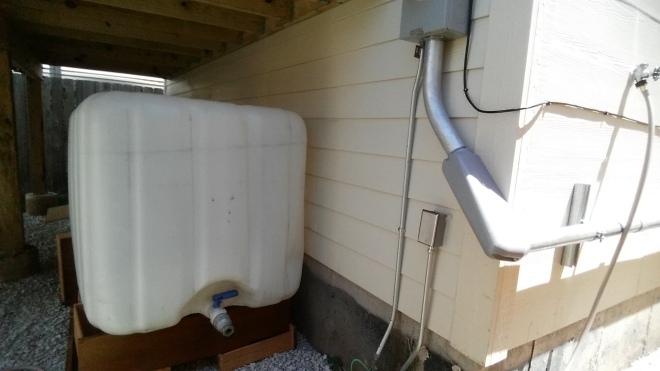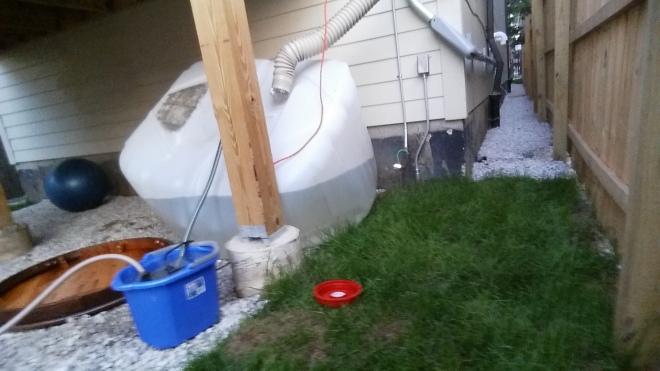I had a fun engineering/problem solving thing today (background at the top of this post; skip down to the ****** for the fun/nerdy part).
It starts with my rain barrel, a device that collects water run-off during storms for use during drier times. It also reduces the strain on the city sewer system, cuts flood risk and is considered a green thing to do.

The problem showed up the first time I actually filled up the barrel: the thing collapsed and completely lost its form and made the faucet inaccessible. Note that these things usually come with metal cages to prevent deformation, but not these ones that my Craigslist seller had gotten for free from a suburban township near Chicago (for the reasons outlined above, suburbs often subsidize or give away rain barrels).

Now, a half full 275-gallon tank holds 137.5 gallons, which wolfram alpha tells us weighs 1147.5 pounds. Way too much for me to move to access the faucet. So I’m kinda stuck and can’t do too much with the thing right now. So…
Primary objective: get the water out of the barrel
Secondary objective: not empty the water by the foundation of the house, and thus invite flooding
Tertiary objective: water the grass
Now, usually you just attach a hose to the barrel and then passively water the lawn/garden, making use of the height gradient to provide pressure. There’s usually not enough pressure for a sprinkler, but just hose watering.
************************
So the solution seems to be an immersible pump. Only problem, the pump I picked up was slightly too big to place fit in the rain barrel opening (see that red cap?). I almost gave up for the day there, but I really wanted to get this out of the way. So then I tried siphoning water from the barrel to the lawn, but given the length of hose (ie. increased resistance) and the lack of a real height gradient, that didn’t work.
Finally, I managed to figure out a way to siphon the water to a bucket just outside the barrel (not easy, but once it’s going, it’s going). While the bucket was filling, I had a few seconds to turn on the pump sitting within it.
Impressed with the pressure coming out of the second hose, I went ahead and attached the sprinkler.
Victory!
But this is where the fun really started. In this system, there was a certain rate X at which water would passively siphon from the barrel to the bucket. And there was another rate Y at which water would be pumped from the bucket to the lawn. So there was a difference X-Y and there was no way of knowing whether that would be positive or negative and by how much.
If X>>Y, then I would have to continually stop the siphon, wait for the pump to empty the bucket, and re-start the siphon, which just wouldn’t work with 140 gallons and a 5-gallon bucket.
If X<<Y, we’d have a similar problem.
A steady state was critical. Luckily, X was only about 1.2*Y. So the bucket would fill after 7-8 minutes and I could just reset it a few times.
BUT, the barrel water height is dynamic! So as the water drained, there was less of a pressure gradient and X would fall (the hose mouth was positioned at the bottom of the barrel to maximize the pressure). At some point, X would be less than Y.
So in order to account for this, I had to dig out several levels with the rocks, above and below ground level. So basically at the start, I placed the bucket at +2, then ten minutes later moved it to +1, then 0, then -1, and finally -2.
So all three objectives were completed and I got a kick out of having to problem solve my way through it. Now I just need to get a pump that actually fits in there and figure out how to unwarp the stupid barrel… and build a higher stand for it and build a cage.